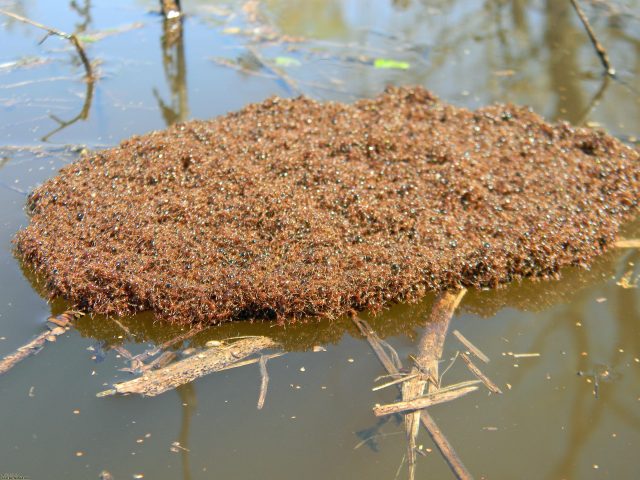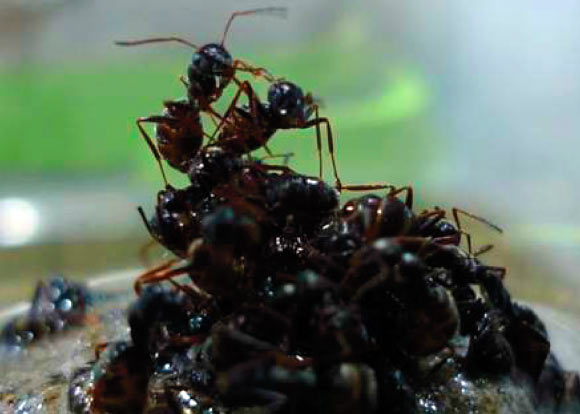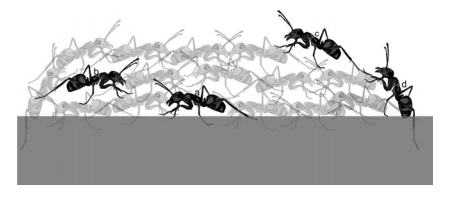Rafting ants
Cooperation is the process of groups of individuals working or acting together for common or mutual benefit. Members of social insect societies cooperate in sophisticated modes. The specialization of individual ants in performing particular tasks or roles tend to increase group efficiency that is best exemplified by workers that display a wide array of specific tasks in colony defense, foraging or brood care. The success of the colony is the sum of all the individual efforts in the collaborative framework. Ants cooperate to move large pieces of food or to hunt big animals but they also can self-assembly joining their bodies in complex biological structures such as bridges, ladders, bivouacs, protective curtains, or rafts.

The Alpine silver ant Formica selysi is an ant species that lives in the floodplains of central and southern Europe. When the terrain is flooded, the ants, like humans do, work together to improve their response to this emergency with different individuals carrying out specific tasks. The nest survives by floating out on rafts build with the own bodies of the worker ants. These ants cluster together by linking primarily tarsi to tarsi, with occasional connections made tarsi to femur, tarsi to mandibles, and tarsi to propodeum, forming a floating self-assembled structure, the raft.
In the raft, there is a different behavior for the principal castes. The queen will sit very still being groomed by the workers in the midst of this emergency. Then, she is lifted up and placed right in the center of the raft under a dome of workers and with a platform of workers below her. Protection of the queen is the first priority whereas the workers are the driving force in the assembly of the raft. Some workers are located on the base of the raft and they can be submerged for hours but there is no mortality by drowning and they survive.
Rafts are also formed in other species of ants such as the red imported fire ant, Solenopsis invicta, native from a broad floodplain and wetland known as the Pantanal. Rafting makes this species competitive in both native and foreign environments since it is a key contributor to its invasive ability. Ants trapped under water escape by lifting themselves to the air-water interface through the use of bubbles collected from submerged substrate. The presence of brood increases colony survival and maximizes raft longevity due in part to the ability of larvae to hold bubbles under hydrophobic setae increasing floatability.1
Previous idea was that simple behavioral rules under positive feedback exponentially attract workers to the first individuals involved and therefore ensure a rapid growth of the self-assemblage. It was supposed that maybe a simple order such as «run to the end of the chain and hang there» is enough to build structures such as chains or ladders. Hence, three-dimensional structures may arise from simple behavioral patterns and individual decisions based on local information. However, it is more complex than that and in Eciton ants, morphologically distinct worker castes differ in their participation to bridge construction. Since there are no discreet morphological worker subcastes in Formica selysi, it is possible that different positions in the raft may be associated with differences in behavioral castes, age and/or body size. For example, workers on the base of the raft with brood may be nurses, while workers on top may be foragers that have slightly larger bodies than nurses.

A group of researchers from the University of Lausanne exposed ants to similar conditions in the lab and two consecutive floods and the ants very much responded based on their prior experience. The research team formed 17 groups of 60 workers, with 20% of the workers marked with paints dots on the abdomen. Each marked worker had a unique combination of colors on both the ventral and dorsal faces that allowed its identification. To initiate a trial, the researchers transferred each group to the watch glass of a tracking apparatus and elicited raft formation by slowly increasing the water level. They track their movements when forming rafts and they found that they exhibit memory and the same ants repeatedly occupy the same positions during raft formation, i.e. the same individuals consistently occupied the top, middle, base or side position in the raft. If workers uniformly follow a single set of assembly rules, it may be expected that they will be positioned at random in each raft. In contrast, workers that spent time on specific parts of the first raft were significantly more likely to spend time in the same positions in the second raft.

In a second experiment, the research team explored the effect of brood presence and prior experience by workers on raft assembly. The presence of brood modifies workers’ position and raft shape. The brood –the larvae and pupae– is located in the basal portion of the raft and can be also submerged but no damage is normally caused on them. In addition, it increases the buoyancy of the raft. Rafts with brood were flattened and contained fewer layers of workers than rafts without brood. Then, these rafts with brood had a larger proportion of workers occupying the base and top positions and a smaller proportion of workers occupying the middle and side positions, as compared to rafts without brood. In this second experiment, the researchers supplemented eight groups of 60 workers with 10 nestmate pupae. Curiously, workers’ experience in the first experiment, building the first raft with brood influenced their behavior and raft shape in the second experiment without brood. The configuration of the second raft without brood did not differ significantly form the configuration of the first raft when brood was present. 2
Jessica Purcell, one of the researchers commented that «an individual ant is not overly intelligent but it is able to follow chemical communication signals from other ants. By working together and through differentiation and specialization on different tasks, they can achieve these pretty marvelous social outcomes. So there is more of a swarm intelligence than sort of an individual intelligence».
The behavior of ants and other social insects is being used as models to design cooperative robots in the fields of swarm robotics and nanorobotics that may ultimately be used in medicine, for such tasks as destroying blood clots, for fabrication of materials or for emergency defense until a natural catastrophe such as an earthquake or, yes, a flooding.
References
- Adams BJ, Hooper-Bùi LM, Strecker RM, O’Brien DM (2011) Raft formation by the red imported fire ant, Solenopsis invicta. J Insect Sci 11: 171. ↩
- Avril A, Purcell J, Chapuisat M (2016) Ant workers exhibit specialization and memory during raft formation. Naturwissenschaften 103(5-6): 36. doi: 10.1007/s00114-016-1360-5 ↩